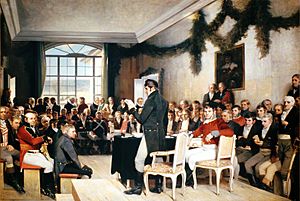Swedish–Norwegian War (1814) facts for kids
Quick facts for kids The Swedish–Norwegian War of 1814 |
|||||||
|---|---|---|---|---|---|---|---|
| Part of the Napoleonic Wars | |||||||
 The constituent assembly at Eidsvoll in 1814 |
|||||||
|
|||||||
| Belligerents | |||||||
|
Supported by:
|
|||||||
| Commanders and leaders | |||||||
|
|
||||||
| Strength | |||||||
| 30,000 8 field batteries 7 brigs 150 gunboats |
45,523 4 field batteries 4 ships of the line 5 frigates 24 smaller ships 60 gunboats |
||||||
The Swedish–Norwegian War was a short but important conflict. It happened in the summer of 1814 between Sweden and Norway. This war led to Norway joining a union with Sweden.
Even though Norway joined Sweden, it kept its own constitution and parliament. This war was the last time Sweden fought another country. After this, Sweden began a long period of military neutrality, meaning it stayed out of wars.
Contents
Why Did the War Happen?
The Treaty of Kiel Explained
In 1812, Sweden's Crown Prince, Charles John, made a deal with Russia. Russia agreed to help Sweden attack Norway. The goal was to make Denmark-Norway give Norway to Sweden.
This attack was put on hold because of the Napoleonic Wars. Sweden's army was needed to fight France in Europe. In 1813, Sweden joined forces with Great Britain and Prussia. They agreed that Norway would go to Sweden if they helped defeat France.
In December 1813, Charles John led his army into Denmark. The Danish king, Frederik VI, had to give up. On January 13, 1814, the Treaty of Kiel was signed. This treaty forced Denmark to give Norway to the King of Sweden.
Norway's Fight for Freedom
The people of Norway did not accept the Treaty of Kiel. They did not want to be traded like a possession. Prince Kristian Frederik of Denmark, who was in charge of Norway, led a rebellion.
He called for a special meeting to create a new government. On May 17, 1814, they adopted a new, liberal constitution. They also chose Kristian Frederik as the king of an independent Norway.
Kristian Frederik tried to get help from other powerful countries. He hoped they would support Norway's independence. However, no country promised to help Norway stay separate.
The Armies and Their Leaders
Norwegian and Swedish Forces
The Norwegian Army had about 30,000 soldiers. They set up their defenses away from the Swedish border. This was to avoid being surrounded. The Norwegian navy was small. Most of its ships were near the Hvaler islands, close to Sweden.
The Swedish Army was much larger, with 45,000 experienced soldiers. They had good equipment. The Swedish Navy had many large ships. They could move troops easily and had help from the British navy.
Key Commanders in the War
- Charles John (Karl Johan) – He was the Crown Prince of Sweden. He used to be a famous French general.
- Johannes Klingenberg Sejersted – A major general for Norway.
- Frederik Gottschalck von Haxthausen – Norway's minister of finance.
The War Begins
The fighting started on July 26 with a quick Swedish navy attack. They attacked Norwegian gunboats at Hvaler. The Norwegian soldiers escaped, but their ships did not fight much after that.
The main Swedish attack came across the border near Halden. They went around the Fredriksten fortress and moved north. Another Swedish force landed near Fredrikstad. This town quickly surrendered.
This was a plan to trap the main Norwegian army at Rakkestad.
Battles and Retreats
Near Kongsvinger, the armies were more evenly matched. The Norwegian army stopped the Swedish advance at Lier on August 2. They won another battle at Matrand on August 5.
On August 3, King Christian Frederik arrived at the front. He was convinced to try a counterattack with 6,000 men. The order was given on August 5, but then called back a few hours later.
The Norwegian forces then pulled back across the Glomma river at Langnes. The last major battle was on August 9 at Langnes. Here, the Swedish forces were pushed back again.
Sweden then tried to go around the Norwegian defenses. They succeeded at the battle of Kjølberg Bridge on August 14. This opened a clear path for them to Kristiania, Norway's capital.
Also, the British navy was blocking Norway's trade. This cut off supplies. With Swedish armies close by, Norway's military situation became very difficult.
Why the War Ended
Even though Norway won some battles, it was clear they could not win the war. Both sides knew that Norway would eventually be defeated. The war was also very expensive for Norway.
Sweden offered to talk about peace. Both sides wanted the war to end quickly. For Norway, it was about getting the best possible deal. Without help from other powerful countries, Norway could not stay fully independent.
By agreeing to talks after the victory at Langnes, Norway was in a better position. They could avoid a complete surrender.
What Happened After the War?
On August 10, Charles John suggested a cease-fire. He made a big promise: he accepted Norway's Eidsvoll constitution. This meant he agreed that Norway would not just be a Swedish province.
Talks began in Moss, Norway on August 10. After a few days, a cease-fire agreement was signed on August 14. This was called the Convention of Moss.
Kristian Frederik had to step down as King of Norway. But Norway remained mostly independent. It joined a personal union with Sweden, under the Swedish king. Norway kept its constitution, with only small changes needed for the union. Both kingdoms kept their own governments, except for the king and foreign policy.
See also
- Gunboat War
- Kingdom of Norway (1814)

